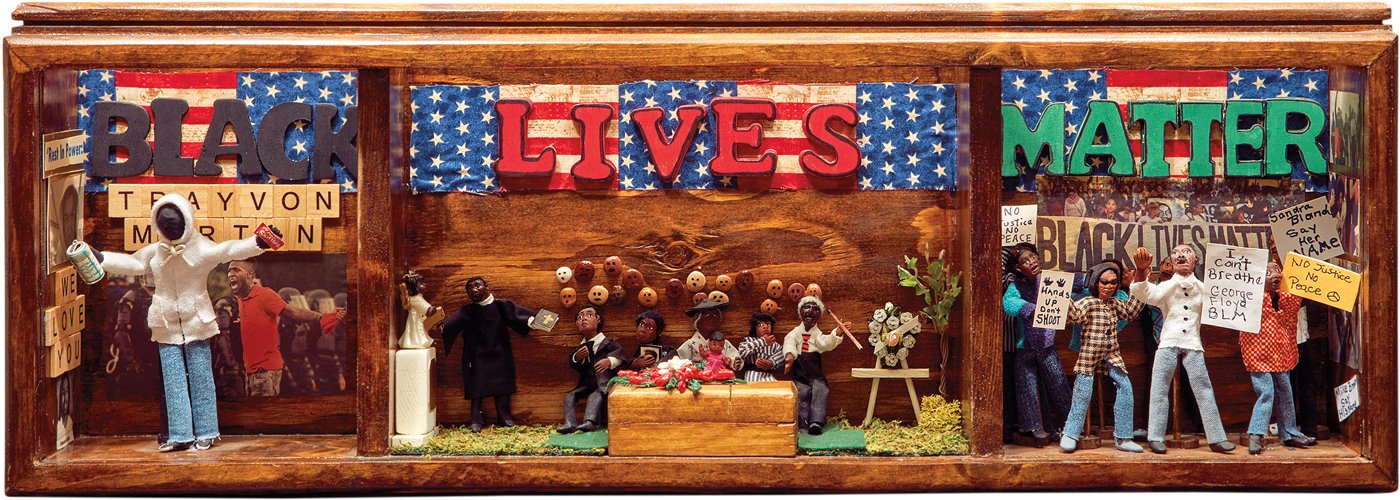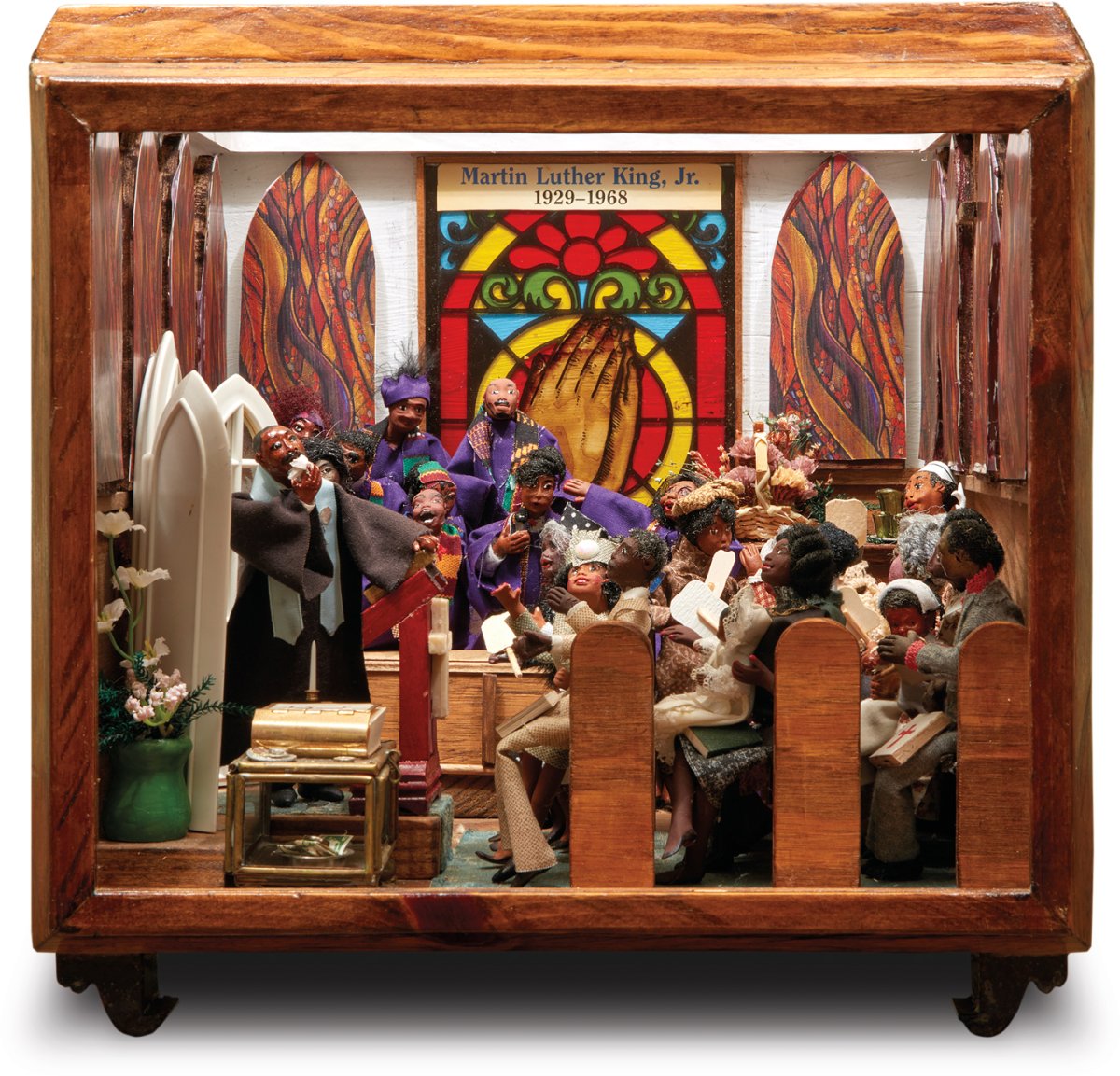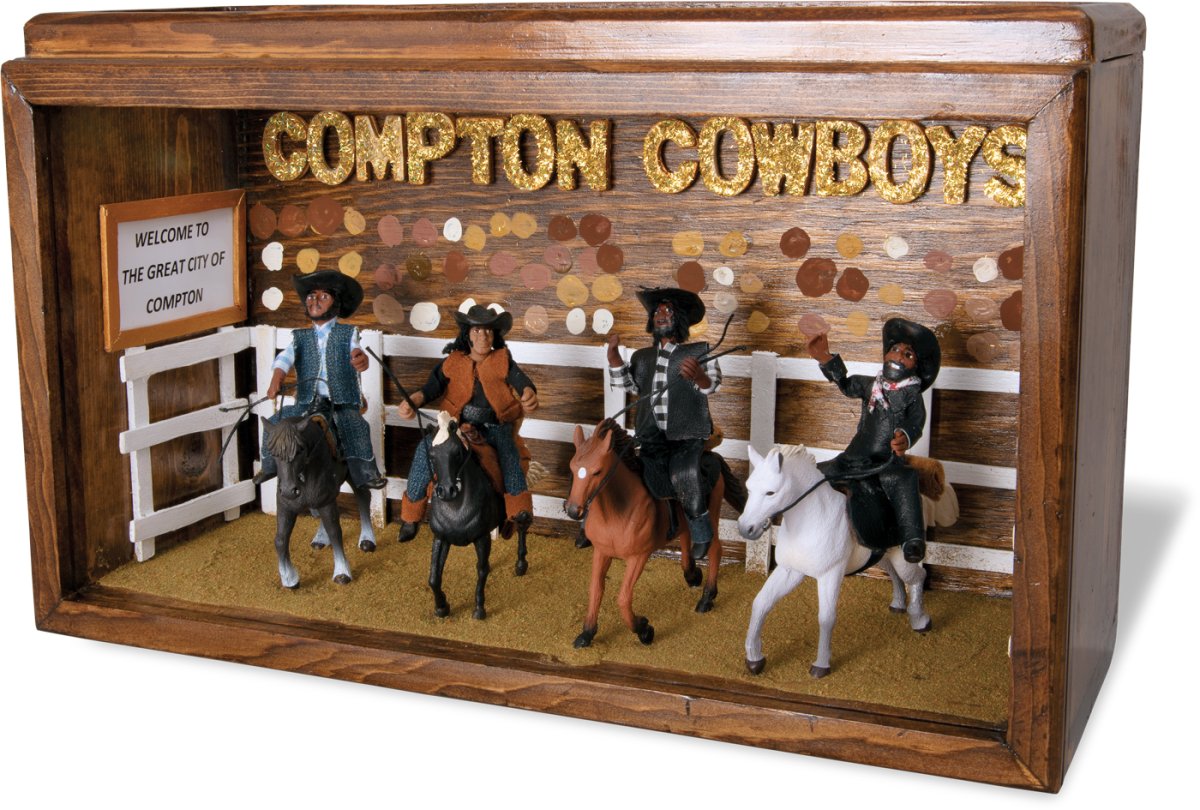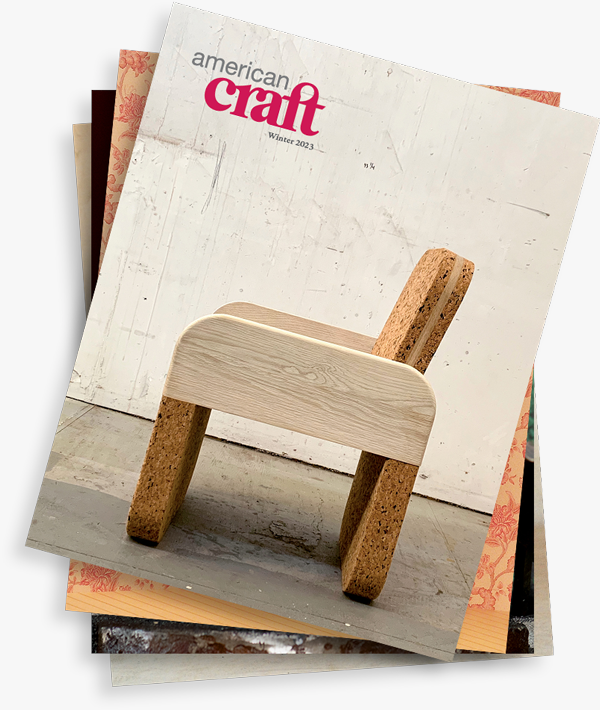Making History
Making History
THE LIVING ROOM OF CRAFT ARTIST and educator Karen Collins’s Compton, California, home is stacked with the dioramas she has constructed over the past 27 years. They show moments from her personal history, as well as that of Black America. In one triptych depicting stages of the Black Lives Matter movement, Trayvon Martin stands in a hoodie with his hands up, followed by a funeral scene and, finally, a protest in which the impassioned figures hold signs, one reading “Hands Up Don’t Shoot.” In another diorama, a representation of the 1960 Greensboro sit-in, four Black students face a tiny white employee, who wields his pointed finger like a knife. The scene is complete with a miniature jukebox and a tiny “WHITE ONLY” sign above the restaurant counter.
“My aim is to teach children the whole story,” says Collins, who sometimes takes her African American Miniature Museum on the road to schools and libraries. “History teaches them to be ashamed, but it’s an education that happens by omission. It’s the shame of, ‘everybody else helped build the nation,’ and there’s no mention of you.”
Collins’s singular work has earned an enthusiastic following. Recently, she created a series of dioramas depicting Black cowboys and scenes from the life of an early Black U.S. Marshal for the Autry Museum of the American West. Her dioramas—each intricately constructed within a rectangular “shadow box” with shallow wooden walls—capture dozens of pivotal moments rendered in three dimensions. Most contain miniature clay renderings of influential Black activists, entrepreneurs, and political leaders, as well as families enjoying hard-won victories in the face of widespread abuses.
Born in 1952, Collins came of age on Indiana Avenue, the center of Black life in 1950s Indianapolis. She remembers strolling with her siblings down the avenue on Saturdays and taking in the smell of barbecue, the sound of live music, and the hubbub from various Black-owned businesses. Across the street from Collins’s home in Lockefield Gardens, one of the nation’s first public housing projects, stood the manufacturing plant belonging to Black hair mogul Madam C.J. Walker, one of the most successful female entrepreneurs of her time. Collins remembers wandering the Walker Building’s commercial area, which included a beauty salon, an auditorium, a drugstore, and a restaurant. “It was all open inside,” she says. “You could see inside the salon; you could watch the women with their shampoo bowls tending to their clients. It was an opportunity to see Black professionals at work, contributing to the neighborhood.”

Black Lives Matter, 2022, commissioned by the Los Angeles Public Library, includes Sculpey and Fimo clay, pipe cleaners, yarn, various fabrics, and a wooden coffin by Eddie Lewis.
Photo by Ryan Schude.
Collins celebrates and perpetuates Walker’s legacy through her work. Two distinct shadow boxes—now housed in the Madam Walker Legacy Center at the former manufacturing plant—commemorate Walker’s journey from rags to riches. One shows Walker standing proudly before a fireplace and gilt-framed flower print, wearing an elegant dress made of fabric and lace, a tiny string of pearls around her neck.
Collins’s love of miniatures developed early and flourished under constraint. “My mother couldn’t afford a dollhouse, so I would build them out of cardboard boxes for me and my sisters,” she says. “I would repurpose White Castle carrying cases for the furniture and tear off squares of toilet paper to make the beds.” Dolls, too, were expensive, so she cut them out of paper, along with the clothing she designed.
Collins participated in much of the history she now teaches through her work. She attended meetings at the Black Panthers’ Midwest headquarters. When she protested her high school’s restrictions on cultural expression, she was jailed with other students. She was elected president of the NAACP youth council in Indianapolis, which afforded her the opportunity to travel. “That gave me a sense of us as a people,” she says, “of where we’d been, of how far we had come and how far we had yet to go.”
“I began creating these scenes because I wanted another chance to teach children about their worth as human beings.”
-Karen Collins
In 1971, Collins followed her family to Compton, where she met her husband and collaborator, Eddie Lewis. Her obsession with miniatures intensified when, in the 1990s, her son was arrested just before his high school graduation. “I began creating these scenes because I wanted another chance to teach children about their worth as human beings,” she says.
At first, she and Lewis put scenes inside wooden cigar boxes. “It was just furniture then, no people,” she says. “Maybe somebody played cards and the cards were lying on the table. I’ve seen miniatures that are exquisite, but they don’t have people in them. If I’d studied interior design, maybe I’d feel differently. But for me, they need to have people to tell the story.

Martin Luther King Preaches, circa 2000. Photo by Ryan Schude.

Compton Cowboys, 2021, commissioned by the Autry Museum of the American West, includes toy horses, wooden guns, Sculpey and Fimo clay, pipe cleaners, suede, wooden letters, and dirt. Photo courtesy of the Autry Museum of the American West.
One of Collins’s first dioramas depicts Dr. Martin Luther King Jr. delivering an impassioned sermon to an enraptured congregation. “That was when I knew I simply had to learn how to make dolls, because this required a whole crowd,” she says. She used the materials she could find in her home after years as a preschool teacher: polymer clay, pipe cleaners, and tacky glue. The dozen or so churchgoers are seated in profile on wooden pews, all sharply dressed—the men in textured suits, the women in elaborate hats, the babies in white lace bonnets. Some have silver strands glinting among the black yarn Collins uses for hair. Their facial expressions range from plaintive to peaceful to exuberant, while Dr. King gestures authoritatively from behind a red lectern. A choir in purple robes looks on, framed by a faux stained-glass window achieved through slick washes of paint.
When Collins ran out of cigar boxes, Lewis taught himself to build the wooden shadow boxes that would become a staple of her practice. Originally, each scene was contained within four opaque borders of wood. Then a friend suggested inserting a strip of glass along the top to allow light to enter. “That made all the difference,” she says. “Everything just took off from there.”
Collins’s dioramas invert what we think we know about the miniature, the shrunken, the condensed. What might be perceived as cute, dainty, or cursory becomes even more potent in its compression by the act of leaning in, of looking closer. We can’t help but consider what falls beyond the margins of the shadow box. And what has been included takes on the glow and weight of the sacred. “I’m just scratching the surface of our history,” Collins says with a wave of her hand. “What I want to do is endless.”
Discover More Inspiring Artists in Our Magazine
Become a member to get a subscription to American Craft magazine and experience the work of artists who are defining the craft movement today.





